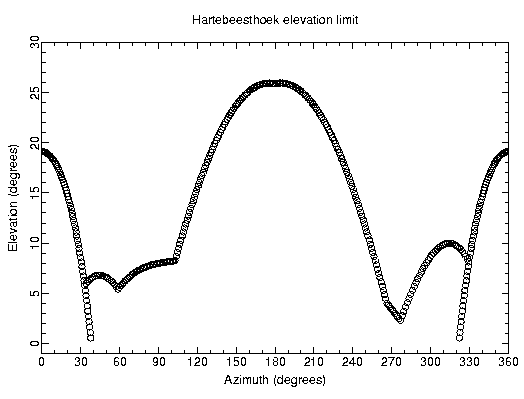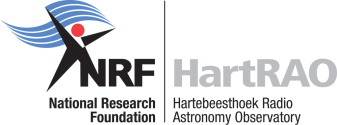VLBI Coordinates of the 26-metre Radio Telescope
The motion of the telescope has been determined from the geodetic VLBI network results by the Goddard Spaceflight Centre VLBI group. ITRF2005 position and velocity shown were obtained from ITRF solutions extraction. The Hart 26m telescope is DOMES 30302S001, cdp 7232.
| Coordinate | ITRF92, epoch 1988.0 | ITRF96, epoch 1997.0 | ITRF2005, epoch 2008/01/01 |
|---|---|---|---|
| X | +5085442.785m | +5085442.780m | +5085442.778m -0.0002m/y |
| Y | +2668263.330m | +2668263.483m | +2668263.699m +0.0193m/y |
| Z | -2768697.188m | -2768697.034m | -2768696.825m +0.0173m/y |
Notes:
Notes:
The algorithm for the hour angle limits as a function of antenna
declination, for angles specified in degrees, is given below as pseudocode.
Note that the local terrain results in an asymmetric horizon.
The absolute northern declination limit is +45 degrees.
The elevation limit as a function of azimuth is shown below.
26-metre Radio Telescope Specification
Diameter 25.9 m Focal Ratio (f/D) 0.424 Surface Tolerance 0.5 mm rms Wavelength Limit 1.3 cm Feed System Cassegrain Pointing Resolution 0.001 degrees Repeatability 0.004 degrees Slew Rate on each axis 0.5 deg/s
Microwave Receivers on the 26-m telescope
Band
<18 cm>
<13 cm>
<6 cm>
<4.5 cm>
<3.5 cm>
<2.5 cm>
<1.3 cm>
Feed horns
1 x circular
1 x circular
2 x diagonal(1)
1 x diagonal + cheesecutter polarizer (2)
2 x circular(1)
1 x circular
1 x circular
Polarization
LCP & RCP
LCP & RCP
LCP & RCP
LCP & RCP
LCP & RCP
LCP & RCP
LCP & RCP
Amplifier
cryogenic HEMT
cryogenic HEMT
cryogenic HEMT
cryogenic HEMT
cryogenic HEMT
uncooled PHEMT
uncooled
Standard frequency (MHz)
1666(2)
2280
5000
6670
8580
12180
23000
Lower frequency limit (MHz)
1608
2210
4650
6008
8180
12048
22000
Upper frequency limit (MHz)
1727
2450
5200
6682
8980
12216
24000
Receiver bandwidth (MHz)3
120
240
400
660
800
168
2000
Beamwidth: full width at half max. (degrees)
0.494
0.332
0.160
0.113
0.092
0.059
0.033
Beamwidth: between first nulls (degrees)
1.19
0.80
0.36
0.32
0.23
0.16
0.073
Minimum system temperature at Zenith (K)
394
44
50
57
60
95
220
Point Source Sensitivity per polarization
(Jy/K/Pol)5
5.14
4.8
5.8
5.1
5.7
5.8
6.0
System Equivalent Flux Density per polarization
(Jy/Pol)5
2004
210
290
290
340
670
1500
Instrumentation
Observing limits for the 26-m Hartebeesthoek Radio
Telescope
IF HA LESS THAN 0.0 THEN
* limit command HA in the east
* southern HA limit
HALIM = -88.0
* HA limit decreases moving north
IF (DEC GREATER THAN -15.0) HALIM = 0.45*DEC - 81.25
IF (DEC GREATER THAN +25.0) HALIM = DEC - 95.0
ELSE
* HA greater than zero, limit command HA in the west
* southern HA limit
HALIM = +88.0
* HA limit decreases moving north
IF (DEC GREATER THAN -5.0) HALIM = -0.3*DEC + 86.5
IF (DEC GREATER THAN +5.0) HALIM = -DEC + 90.0
END IF

